
by NATASHA KURCHANOVA
Much of the art-viewing crowd who come to the main building of the Moscow Museum of Modern Art on Petrovka Street find themselves on the third floor, at an exhibition of 10 installations by Alexandra Dementieva, where they stay much longer than they might have expected. Dementieva, who was born in Moscow in 1960, is a Belgium-based installation artist who works with new media and technology. The selection of her installations, carefully picked by Moscow curator Elena Selina, focuses on pieces that actively engage the viewer in the process of performance – displaying the viewer’s act to themselves and others. The exhibition embraces the period from the early noughties until now.
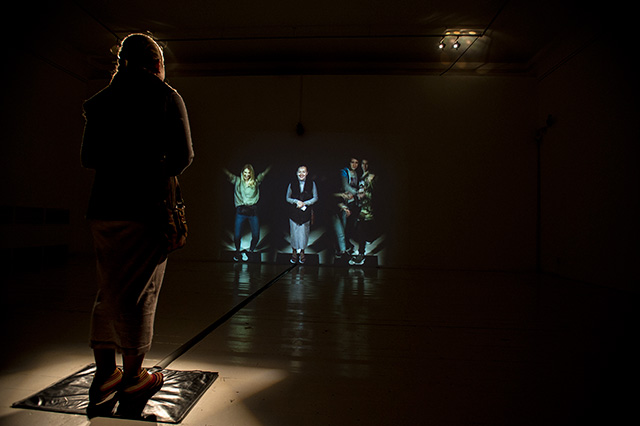
Alexandra Dementieva. Mirror’s Memory, 2003. Installation at MMoMA, Moscow, Russia. Photograph: Evgeny Gurko.
In the earliest installation, Mirror’s Memory (2003), the viewers/participants step on to the carpet in front of a mirror/screen, which displays the visitors to themselves and others – if they happen to be in the room – making the visitor an actor in a one-person show. For her latest installation, Sleeper (2015-6), a series of woven tapestries, the artist compressed Woody Allen’s film of that name, transforming it into fabric in the process. In other words, Dementieva de-digitised the film, converting it into a primitive artefact. However, she also invited technology back into it by instructing viewers to upload the Blippar app to their smartphones to extract histories of the images narrated by imaginary archaeologists of the future, who, according to Dementieva’s scenario, discovered the tapestries long after our civilisation was gone.
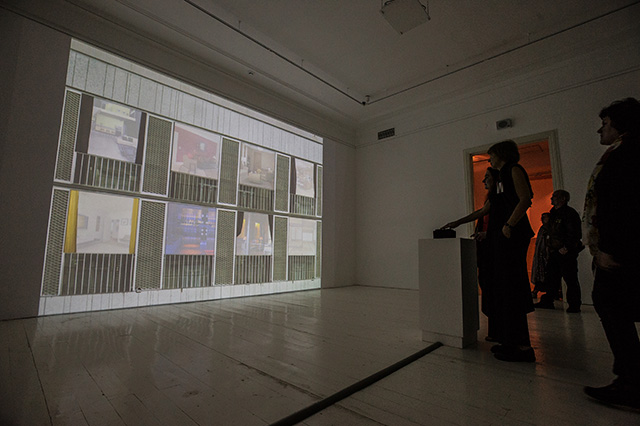
Alexandra Dementieva. Drama House, 2009. Installation at MMoMA, Moscow, Russia. Photograph: Evgeny Gurko.
As Selina observed in her catalogue essay, Dementieva’s worldview is defined by a certain attachment to a literary and cinematic narrative. Many of her installations either involve a story, or may serve as the beginning of one that participants can write for themselves. In Drama House (2009), for example, viewers are given control of what is seen on eight screens placed in front of them in two vertical rows. As soon as they press the buttons on an operating panel, characters begin to appear on previously empty screens and perform various actions, from standing to dancing and even stripping. An explanatory wall text, written by Selina, calls these actions “stories, from dramatic to romantic”, which introduce us to characters on the screens. The text explains that we have an opportunity to control these characters: “What is to happen to the dwellers after one pushes the button depends on both which numbers are pressed and in what order.” Dementieva engages the viewer in a public performance gently and with good humour; there is never any attempt to make the person feel uncomfortable. This exhibition is supported by XL Projects, Moscow, and Cyland Media Art Lab. It is the artist’s first solo show in a museum.
Natasha Kurchanova: Congratulations on your first solo exhibition at a museum. It is very popular – there were many people visiting, when I was there. Could you tell me why all the installations are interactive? They all appear to engage the viewer in some sort of a game or act.
Alexandra Dementieva: All art is an interactive game, in a sense. Viewing art is a process: you need to go to a gallery or a museum, get a ticket – or not – look at something, try to understand it … Usually, this experience involves entering a large, light-filled exhibition hall filled with paintings or sculptures. As you are undergoing this experience, you may have feelings of sadness, happiness, contemplation, etc. These feelings are one point of the game, because they show you that you went to seek art for no known reason. You simply follow the rules; you put yourself in the situation of a socio-cultural game. Most of the time, you remain a person whose presence does not change anything. The museum may hope that you purchase something in its shop and perhaps even buy some presents for people.
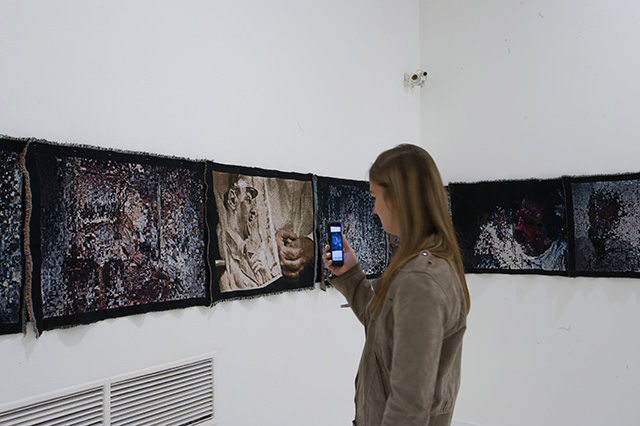
Alexandra Dementieva. Sleeper, 2015-2016. Installation at MMoMA, Moscow, Russia. Photograph: Evgeny Gurko.
I am interested in the further action on the viewer’s part – the one that surpasses all these steps. I am offering the viewer an opportunity to take an active part in an artwork. Without the viewer’s participation, the artwork will not be complete. It is true that in this case, I set the frame for what they can do in a performance. Usually, it is impossible for a visitor to surpass the limits of this frame. However, all of us act in some sort of a frame, which we cannot overcome. At the moment in which the visitor goes a little beyond their comfort zone and begins experimenting, they assume the position of a performer. In this role, the visitor is not only an observer, but is also a participant in an action. For me, this is more sensible: when we simply observe something, we find ourselves in a certain niche, where we are safe and secure, even free to imagine ourselves outside any social contexts; when viewers become committed to an action within my installation, they begin uncovering themselves to others to a certain extent. Also, if they are actively involved with a work like this, there is more chance that they will think about what this work may mean.
NK: I see this tendency in your work as taking the viewer beyond the conventional screen – and I like it very much. The screen acts as a limit, a barrier, and a frame in a certain sense. It seems to me that your project is breaking this frame of the screen by framing the work differently.
AD: Yes, I am trying to frame the work and the viewer differently – although the viewers are not uniform, and neither are they static. It used to be that most viewers went to museums and looked at works. Now, with the huge popularity of social media, it is becoming clear that many people have this urge to exhibit themselves in a performative sense. I am not talking about pornographic sites, but about many stranger exhibitionist manifestations that stun me. For example, there are so-called “stuffers”, people who feed themselves to death while being watched by thousands of anonymous viewers for years on social media. They start at a normal human size of 50 kilos, they reach 400 kilos and die in front of the camera. I watched a programme about one such stuffer from Brooklyn: people were sending her money and food to enable her to complete her goal to become the fattest woman in the world. I feel it is a strange degradation of a normal person into the fattest one, who cannot move or breathe. In the beginning, I thought they were making money by doing it, but now I am convinced that they are giving way to their exhibitionist drive. And, of course, there are millions of posts of people singing, crying, having sex, etc. That’s why I think the public also changes rather drastically by receiving an opportunity to become a character whom someone may want to watch.
NK: It sounds as if you are trying to unearth an exhibitionist element, a wish to perform, which exists in every human being, but you are framing it in such a way that it is not pathologised, but normalised. You do this, for example, in The Unbearable Lightness (2009). Could you tell me more about this installation?
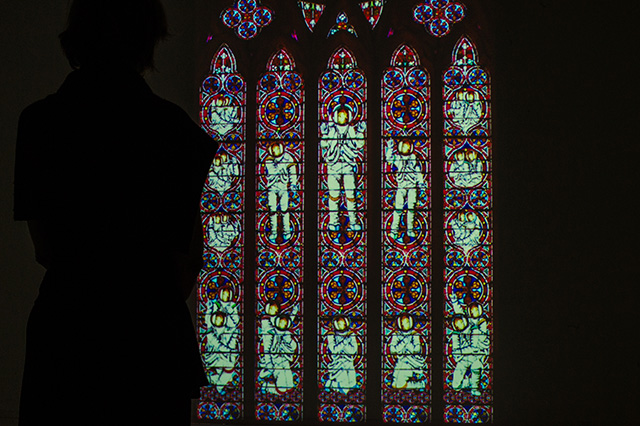
Alexandra Dementieva. Unbearable Lightness, 2009. Installation at MMoMA, Moscow, Russia. Photograph: Evgeny Gurko.
AD: It is the most sadistic installation I have ever made, because I make people stay still for slightly more than four minutes to watch the transformation of an image of a gothic stained-glass design. I created this installation because I really wanted to stop time, or at least to slow it down. I wanted to make the time tangible, so that we have an opportunity to contemplate it. Hopefully, this will make some of us realise that the time we give to art is very short. I call it the most sadistic of my installations because, when you leave the carpet on which you are supposed to stand, the picture returns to its initial state, and does not change unless someone stands on that carpet for four minutes. If you stay until the end, you understand that everything is not that simple, and that even saints can turn into astronauts and fly into space.
NK: Could you tell me about the installation Breathless (2012), where viewers can change lights pattern of LED stripes in the wired cylinders in which they stand by blowing into air receptors?
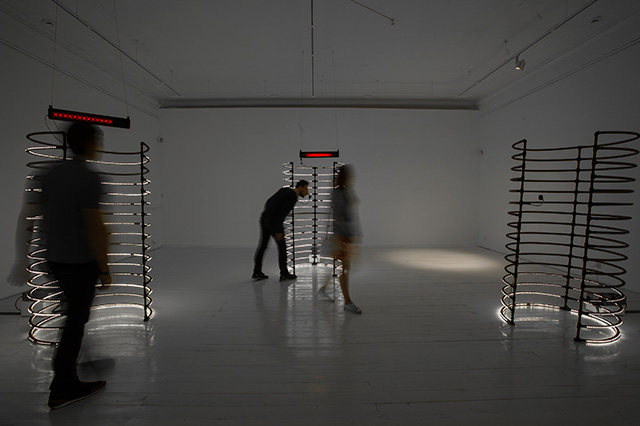
Alexandra Dementieva. Breathless, 2012. Installation at MMoMA, Moscow, Russia. Photograph: Evgeny Gurko.
AD: The installation consists of three wired cylinders. One cylinder is linked up to an internet news feed that is tuned to words that relate to “fear”, another to “desire”. For me, these two words designate the most significant motors for human activity. If you see a word light up on top, then the computer looks for this word on the internet and if it finds one, then only one line of lights will be lit up; if it finds two – two lines will light up, and so on. All the words are in English because, for technical reasons, it would have been very difficult for me to restructure the entire system of this installation for the Russian language – my LED display is constructed to work with the Latin alphabet. The third cylinder functions according to the same principle, but instead of being connected to news feeds, it wirelessly measures the levels of noise and pollution on the nearby street. Then, I introduce into this machine a human intervention – breath – which breaks the mechanised cycle of predictability by making the light levels go way up. Ultimately, the work is about the fact that our mental constructions – the ideas on which this world is resting – are not always correct. In my installation, this complex but ephemeral reality disappears with our breath. At this moment, all the legible words on the tableaux above the installations turn into illegible signs. This happens only when the viewer enters a cylinder and breathes into its receptor. As soon as the visitor leaves, the initial cycle resumes, because the system is ultimately stronger than the individual, but still there is the hope of making a better world thanks to individual involvement.
NK: This was the most enigmatic installation for me, so thank you for this explanation. I also like the installation Alien Space (2008). I noticed a strong smell of resin when I entered it.
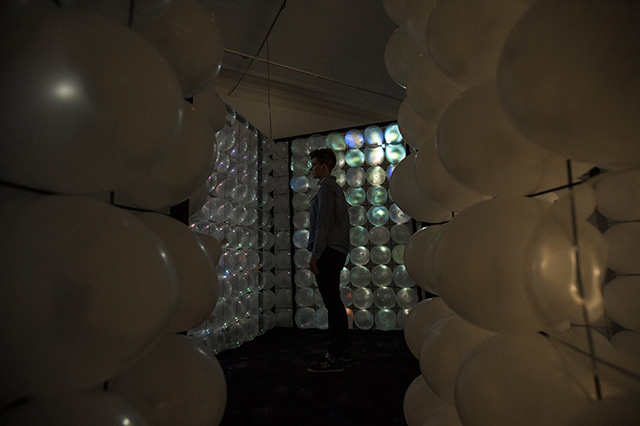
Alexandra Dementieva. Alien Space, 2008. Installation at MMoMA, Moscow, Russia. Photograph: Evgeny Gurko.
AD: Alien Space consists of 600 balloons, each tucked into a square in a large wooden grid. As we move along the corridor decked with balloons towards the back of the installation, we notice that each balloon reflects a projection of a TV announcer who broadcasts, in one of 67 languages, an international news feed from one particular day in the past. Gradually, this announcer turns first into an alien, then into a robot, and then back into its original form. I created this installation to test my idea that, psychologically, we are conditioned to experiment and try something new. I am attracted to making art, because it is reflecting what’s going on in this world at this moment. I am intrigued by this play of reflection. In the olden days, religion had to deal with this particularity of human character by trying to contain it. Now, we can see a return of all the classical and orthodox religions, a sort of counter-Enlightenment, an intensification of religious traditions that creates a different space for people’s imagination. A multitude of popular internet sites that are connected with aliens, robots, and artificial intelligence are also a part of this mythologising trend. Contrary to popular belief, they do not indicate interest in new technologies, but rather the return to metaphysics and the creation of new belief systems. You can see the projections from the hallway, but as you come closer, they disappear, unless you come very close. The languages and speech patterns change depending on your position within the installation. At some point, you may have the impression of a cacophony of sounds. It is also possible to hear each language separately. Galleries and museums do not like this installation because it requires a lot of maintenance – the balloons need to be re-inflated constantly. It corresponds to the situation in life, where our belief in metaphysics – our gods – needs to be constantly maintained. If there is no one to maintain it, the installation would cease to exist.
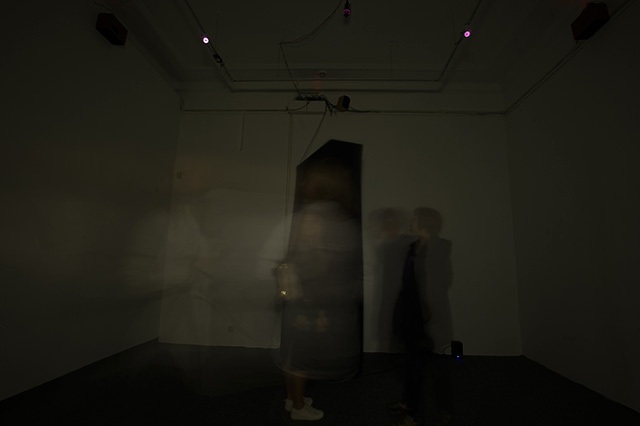
Alexandra Dementieva. Monolith, 2010. Installation at MMoMA, Moscow, Russia. Photograph: Evgeny Gurko.
NK: Your installation Monolith (2010) is rather straightforward: it is about fear. The viewer enters a dark room, hears a menacing sound, sees a threatening shape that can suddenly jerk forward at them, and becomes frightened. I was scared to be in the room with Monolith. Next to it is Cycloramadrome (2014). What is it all about?
AD: It’s about people’s love of moving images – iconophilia. The viewer enters a large circular space, inside which a panoramic video is shown. First, you see one female character walking around in a robe and looking at you. The longer you stand there, the more virtual characters come to look at you. In this installation, the viewer becomes the main actor, because they are not the one looking at the characters; instead, the characters look at the viewer.
NK: One of the installations was closed because it was not working properly.
AD: Limited Spaces – 2 (2005) broke down because the museum visitors in Russia have been using the installation too vehemently. They pushed it to the limit, and it crumbled. The point of the installation is a coordination of two acts: that of the viewer turning the pedals on a bicycle and of a woman who is concealed behind a screen and moves according to the speed at which the viewer pedals. There is also a film projection, which begins when the viewer starts pedalling. In order for the viewer to watch the film until the end, they must keep pedalling. The stability of this installation depends on a metallic piston, which is the structural core of the entire mechanism. People were pedalling so hard that the metal from which the piston is made began to melt. I could not change the piston because it would require a reinstallation of the entire piece, so now I am trying to make it work in a different way. I need to proceed with extreme caution because if the metal melts any more, it will be impossible to de-install the piece. It was a big surprise when I received the news that this installation had broken, because it was exhibited in other places, and had withstood all kinds of use. I am trying to fix it now, but it is difficult to do at a distance, because of an inevitable distortion of information, which is transmitted digitally with an inevitable delay in time, and therefore can change, but the change cannot be verified.
NK: Instead of Limited Spaces, the public was standing in line to use your Stalker/Brain Scanner (2006). I had to wait a while for my turn.
AD: Which images related to your subconscious did Stalker show you?
NK: While I was waiting in line and watching other people sitting inside Stalker’s black box, I heard sounds of battles, explosions and commotions, which suggested to me that they were seeing very active representations of what was going on in their subconscious. When my turn came, I saw a very quiet and peaceful range of mountains; nothing suggesting anything even remotely violent.
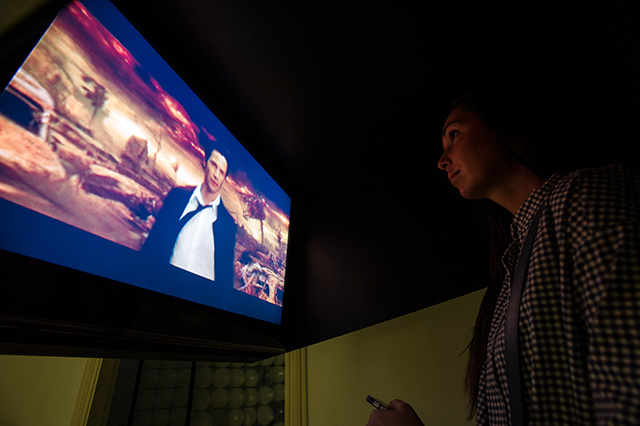
Alexandra Dementieva. Stalker/Brain Scanner, 2006. Installation at MMoMA, Moscow, Russia. Photograph: Evgeny Gurko.
AD: This piece works with the help of a sensor that determines the distance of the person sitting inside the installation and the screen. The mechanism kicks in when the person is fixed in the seat and stops moving. What is interesting in this installation is its resemblance to playing roulette in its randomness. It is impossible to calculate which film a person will get to watch. It is unique for everyone. People like this installation because it allows them to “watch their future”, so to speak. I can tell you a story about a good friend of mine from Germany. She was using Stalker, and I was peeking in to see what she was viewing on the screen. It happened to be a big wedding feast, and I jokingly said: “It looks like you will get married soon.” She became very angry at me, saying that she had two grown children and no intention of getting married. A year later I received an invitation to her wedding. She thought it was a coincidence.
NK: What about the last piece you made for this exhibition, Sleeper (2015-6)? I find it intriguing, because it contains a story within a story, your narrative overlapping with Woody Allen’s film.
AD: This project is the result of an accident. I was watching Woody Allen’s film Sleeper and my computer crashed and compressed the film into 194 frames, of which I have made 100 tapestries so far. The project is ongoing; I am still involved in the production of the mats. I love Woody Allen’s films and particularly the period of the 1970s. This film is about the future. Unlike my work, this film is anti-utopian. The future in my work is not so clear-cut. I imagined a group of archaeologists of the future who discovered these tapestries after the post-scientific era on our planet Earth and are trying to define them. They belong to an undefined social structure. Since the tone of the narrative is rather calm, one can guess that it is a different society with a different attitude towards the world.
NK: What can you say about the narrative accompanying this installation? I find some of the stories hilarious, such as the one describing Charles de Gaulle, for example.
AD: The idea behind the audio is very simple: the archaeologists are trying to figure out what the tapestries are all about and conclude that it is a system of archiving of digital media, such as films, for example. After this, they find journals and other [non-digital] media piece by piece. The story is about various ways of archiving the media. Every tapestry has its own story of how it was found. You can listen to it one by one, or you can listen to the entire series, which will take you 25 minutes in total. The story about Charles de Gaulle is a quote from the movie. Woody Allen has a great sense of humour.
NK: What inspires your work?
AD: There have been many sources of inspiration for my work over the years. Nowadays, it is life itself and people with their feelings and acts. I am very much drawn to the work of David Lynch, and I am now watching the third season of Twin Peaks. I consider him a genius. His latest episodes are extremely strange. One programme in this series left me chained to my seat. He is a great master of leading the viewer along unexplored and illogical paths. The scenes stay in our memory, but they seem inessential to the action. He seems to speak about possibilities of our existence that may or may not happen.
NK: One of the wall texts mentions Bill Viola as one of your major influences.
AD: I love Bill Viola, because he is concerned with symbols, such as birth, life, death – the essential stages of human life – which are also eternal concerns of art and religion. My installation Stalker is inspired by Andrei Tarkovsky’s film with the same title. There I composed phrases from popular films that convey a certain message.
• Alexandra Dementieva: 10 Installations is at the Moscow Museum of Modern Art until 20 August 2017.